Digs & Discoveries
Kunga Power
By MARLEY BROWN
Monday, April 25, 2022
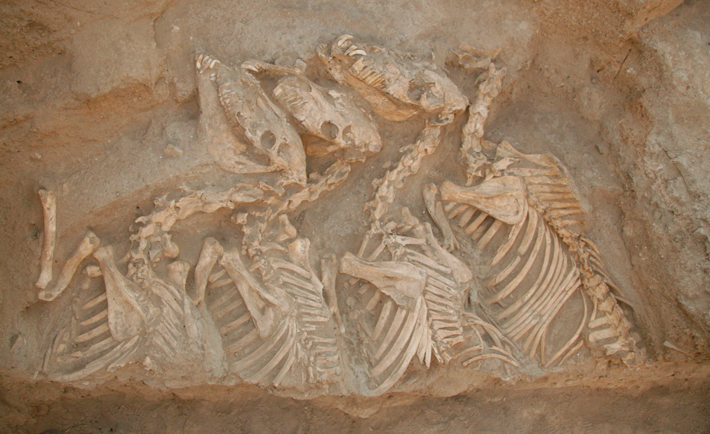 Domesticated horses are thought to have arrived in Mesopotamia around 2000 B.C., but before then, Sumerian scribes wrote of another type of equid, the family that includes horses, donkeys, and zebras. These animals were used to pull war wagons in battle and were given as royal dowries. The precise zoological classification of these animals, called kungas—a transliteration of the ancient Akkadian symbol meaning hybrid equid—had never been determined. Recently, a team of researchers analyzed the remains of equids that were discovered in a cemetery dating to between 2600 and 2200 B.C. at the site of Umm el-Marra in what is now Syria. They concluded that the characteristics of the animals’ skeletons do not fit with those of donkeys, which arrived in Mesopotamia from Egypt, where they were first domesticated around 3800 B.C. They also do not fit with those of a type of local wild ass called a hemippe that went extinct in the 1920s.
Domesticated horses are thought to have arrived in Mesopotamia around 2000 B.C., but before then, Sumerian scribes wrote of another type of equid, the family that includes horses, donkeys, and zebras. These animals were used to pull war wagons in battle and were given as royal dowries. The precise zoological classification of these animals, called kungas—a transliteration of the ancient Akkadian symbol meaning hybrid equid—had never been determined. Recently, a team of researchers analyzed the remains of equids that were discovered in a cemetery dating to between 2600 and 2200 B.C. at the site of Umm el-Marra in what is now Syria. They concluded that the characteristics of the animals’ skeletons do not fit with those of donkeys, which arrived in Mesopotamia from Egypt, where they were first domesticated around 3800 B.C. They also do not fit with those of a type of local wild ass called a hemippe that went extinct in the 1920s.
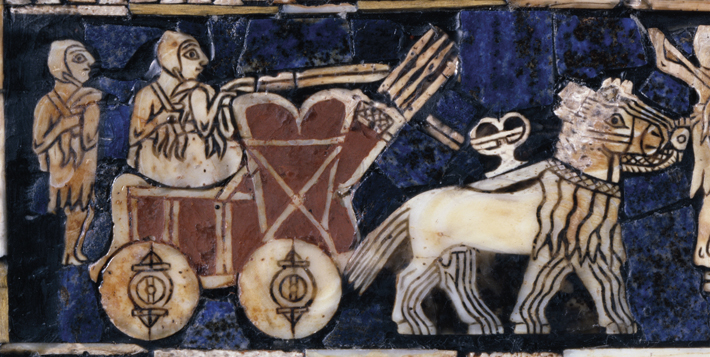 The team sequenced the genomes of the Umm el-Marra equids and two hemippes that survived into the early twentieth century as well as the genome of an 11,000-year-old hemippe discovered at Göbekli Tepe in Turkey. They determined that the animals buried at Umm el-Marra were hybrid offspring of female domesticated donkeys and male hemippes. This, says paleogeneticist Eva-Maria Geigl of the Jacques Monod Institute, is the earliest known evidence of animal hybridization. “Before they acquired horses, ancient Mesopotamians needed fast, strong equids that they could train to carry soldiers into battle,” says Geigl. “Donkeys are cautious, smart animals that will not run, especially not towards a hostile force, while wild asses, who are fast and less fearful, are virtually untamable.” By breeding kungas, Geigl explains, ancient Mesopotamians combined the optimal traits of both animals. However, while the offspring would have been healthy, they would also have been sterile, meaning the hybridization process would have had to be repeated for every generation.
The team sequenced the genomes of the Umm el-Marra equids and two hemippes that survived into the early twentieth century as well as the genome of an 11,000-year-old hemippe discovered at Göbekli Tepe in Turkey. They determined that the animals buried at Umm el-Marra were hybrid offspring of female domesticated donkeys and male hemippes. This, says paleogeneticist Eva-Maria Geigl of the Jacques Monod Institute, is the earliest known evidence of animal hybridization. “Before they acquired horses, ancient Mesopotamians needed fast, strong equids that they could train to carry soldiers into battle,” says Geigl. “Donkeys are cautious, smart animals that will not run, especially not towards a hostile force, while wild asses, who are fast and less fearful, are virtually untamable.” By breeding kungas, Geigl explains, ancient Mesopotamians combined the optimal traits of both animals. However, while the offspring would have been healthy, they would also have been sterile, meaning the hybridization process would have had to be repeated for every generation.
First Falconer
By DANIEL WEISS
Monday, April 25, 2022
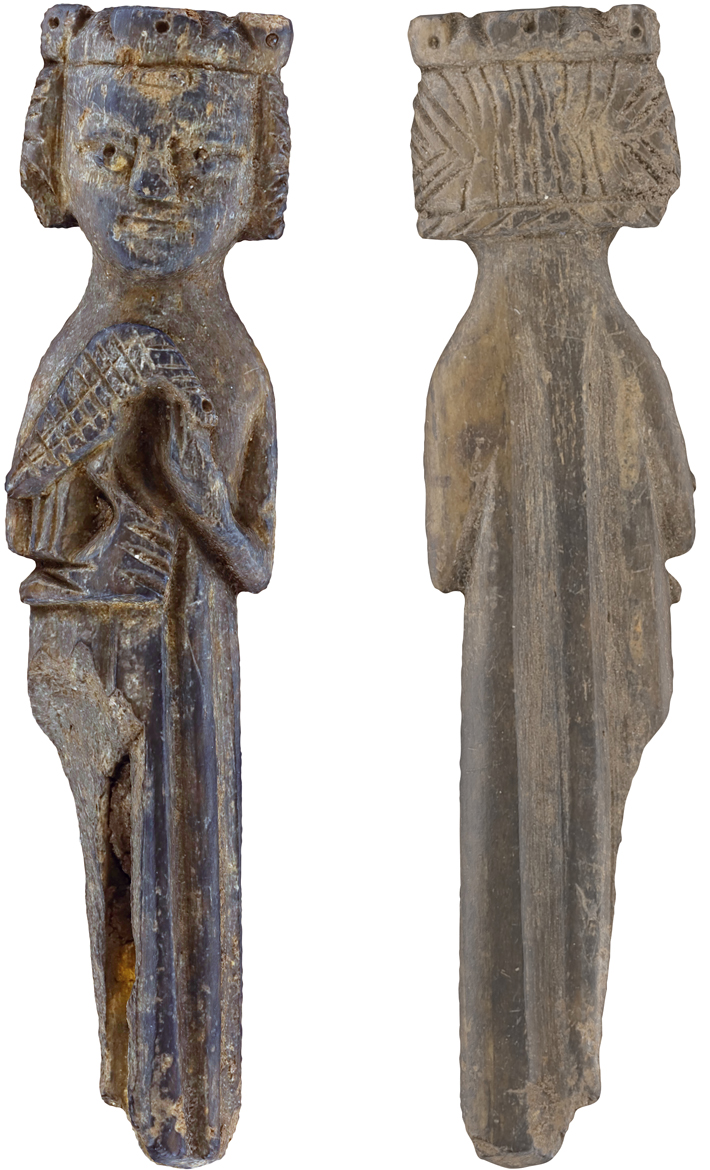 Archaeologists in Oslo have unearthed a three-inch-tall wooden figurine depicting a crowned figure with a falcon perched on its right arm. Based on the figurine’s clothing and hairstyle, it has been dated to the mid-thirteenth century, making it among the earliest known depictions of a falconer, according to Kjartan Hauglid, an art historian at the Norwegian Institute for Cultural Heritage Research. The figurine’s date places it within the reign of Haakon Haakonsson, who was king of Norway from 1217 to 1263 and was known as an avid falconer. It’s possible that the figurine was meant to represent the king, though Hauglid believes it could also represent a young prince or noblewoman.
Archaeologists in Oslo have unearthed a three-inch-tall wooden figurine depicting a crowned figure with a falcon perched on its right arm. Based on the figurine’s clothing and hairstyle, it has been dated to the mid-thirteenth century, making it among the earliest known depictions of a falconer, according to Kjartan Hauglid, an art historian at the Norwegian Institute for Cultural Heritage Research. The figurine’s date places it within the reign of Haakon Haakonsson, who was king of Norway from 1217 to 1263 and was known as an avid falconer. It’s possible that the figurine was meant to represent the king, though Hauglid believes it could also represent a young prince or noblewoman.
The figurine has a hollow bottom and was likely designed as a haft for a small knife or hairpin, but Hauglid believes it was discarded shortly after it was crafted. “Most of these knife handles are very worn and have been used for a long time, possibly for generations,” he says. “This one is very crisp and clear in the details and that could be because it was broken and dumped where it was found.”
Together Forever
By JARRETT A. LOBELL
Monday, April 25, 2022
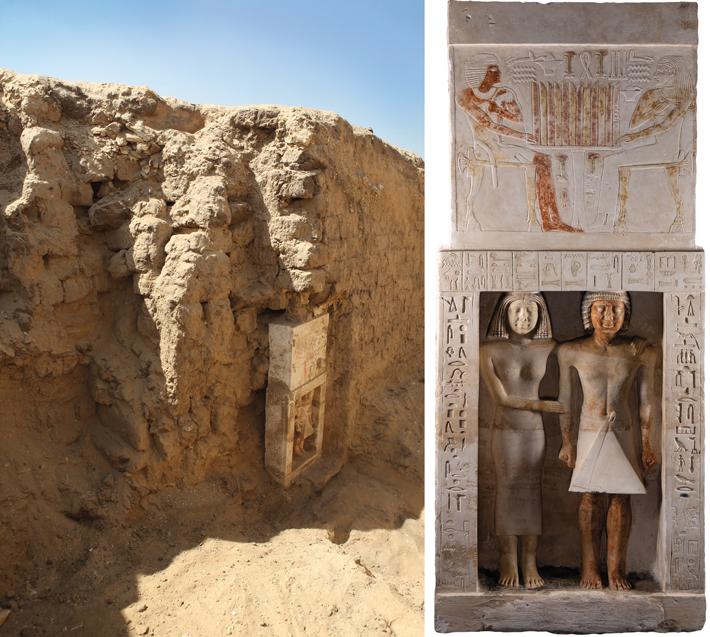 During excavations at the necropolis of Abusir, Egyptologists discovered an unusual funerary monument embedded in an Old Kingdom mudbrick mastaba tomb dating to the 4th Dynasty (ca. 2575–2465 B.C.). The recently uncovered stela, however, dates to the first half of the 5th Dynasty (ca. 2465–2323 B.C.) and memorializes a scribe of the treasury named Sekhemka and his wife Henutsen. “Sekhemka was probably a rather low-level official and died much younger than expected,” says Egyptologist Martin Odler of Charles University. This may be why an older tomb was reused.
During excavations at the necropolis of Abusir, Egyptologists discovered an unusual funerary monument embedded in an Old Kingdom mudbrick mastaba tomb dating to the 4th Dynasty (ca. 2575–2465 B.C.). The recently uncovered stela, however, dates to the first half of the 5th Dynasty (ca. 2465–2323 B.C.) and memorializes a scribe of the treasury named Sekhemka and his wife Henutsen. “Sekhemka was probably a rather low-level official and died much younger than expected,” says Egyptologist Martin Odler of Charles University. This may be why an older tomb was reused.
The white limestone stela is 3.5 feet tall and 1.5 feet wide and depicts the couple standing in a doorway. In a relief atop the doorway, the pair is seated at an offering table covered with 12 loaves of bread. Hieroglyphic inscriptions around the table indicate that Sekhemka and Henutsen should fare well in the afterlife. These inscriptions suggest they would ideally be buried with lighted incense, 1,000 pieces of alabaster, 1,000 pieces of linen, 1,000 loaves of bread, and 1,000 jars of beer, as well as seven sacred oils, including the “best cedar oil” and other, less easily identifiable substances such as “festive oil.”
The offering scene, doorway, and hieroglyphs surrounding the figures were all once painted in rich shades of red, yellow, blue, green, and black. A surprising amount of the pigment survives. Aside from the rarity of preserved paint, Odler explains that the stela is significant because it combines well-known elements of funerary monuments in a completely unique way. “The stela shows that our knowledge of the Old Kingdom is limited,” he says. “We can still find unexpected artifacts that make Old Kingdom Egyptians more human and more creative than expected.”
Canyon of the Ancestors
By DANIEL WEISS
Monday, April 25, 2022
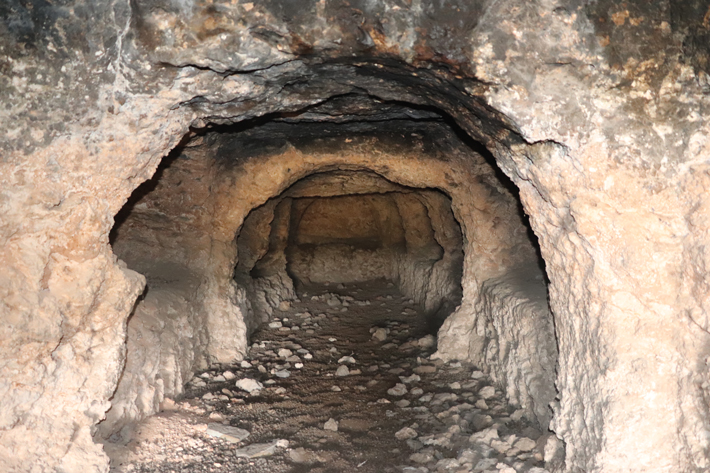 Inhabited as a colonial city by Macedonian soldiers in the third century B.C., the hilltop settlement of Blaundos in western Anatolia is surrounded by a deep canyon on all sides into which its inhabitants carved hundreds of burial chambers. Although the necropolis has been known for centuries, it is only recently that a team led by archaeologist Birol Can of Uşak University has begun to systematically investigate the unexplored tombs.
Inhabited as a colonial city by Macedonian soldiers in the third century B.C., the hilltop settlement of Blaundos in western Anatolia is surrounded by a deep canyon on all sides into which its inhabitants carved hundreds of burial chambers. Although the necropolis has been known for centuries, it is only recently that a team led by archaeologist Birol Can of Uşak University has begun to systematically investigate the unexplored tombs.
In 2021, the team documented around 400 burials dug into the canyon walls. According to Can, the chambers were initially built as single rooms and some were expanded over the generations to make room for sarcophagi holding additional family members. Some eventually held as many as 30 burials. Coins and pottery fragments found in the tombs, as well as the style and iconography of frescoes covering many of their walls and ceilings, indicate that the burials date to the Roman period, from the second to fourth century A.D. The intricate, colorful frescoes, which depict plants and flowers, animals such as birds and dogs, and mythological characters, have deteriorated over the centuries due to causes including illegal excavations, water damage, and fires set by shepherds who used the chambers to house their animals.
There are hundreds of additional tombs still to be excavated, including many that likely date to earlier in Blaundos’ history. “The fact that the whole city was surrounded by the tombs of the Blaundians’ ancestors must have given them spiritual confidence,” says Can. “We can guess that people regularly visited the necropolis during the period when it was used.” For additional images, click here.

Cradle of the Graves
By MARLEY BROWN
Monday, April 25, 2022
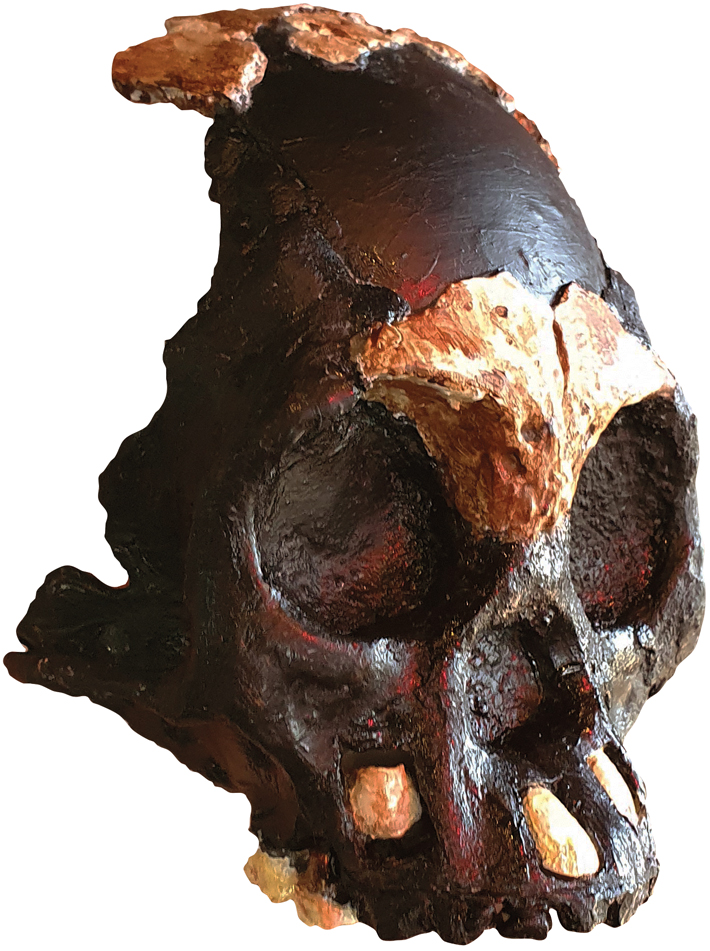 When the skeletal remains of more than a dozen hominins were first uncovered in the Dinaledi chamber of South Africa’s Rising Star cave system in 2013, researchers believed they had discovered a species that lived around two million years ago. The species, which scholars named Homo naledi, shared characteristics with early hominins such as Lucy (Australopithecus afarensis), including a wide-flaring pelvis, apelike shoulders adapted for climbing, and a brain around one-third the size of a modern human’s. But it also exhibited some traits that are very much in line with modern humans, such as the feet and long legs typical of a biped and hands and wrists suited to making tools. Dating of H. naledi remains in 2017 determined that these hominins actually lived between 335,000 and 236,000 years ago—at least a million and a half years later than initial estimates—a period when modern humans also lived on the African continent.
When the skeletal remains of more than a dozen hominins were first uncovered in the Dinaledi chamber of South Africa’s Rising Star cave system in 2013, researchers believed they had discovered a species that lived around two million years ago. The species, which scholars named Homo naledi, shared characteristics with early hominins such as Lucy (Australopithecus afarensis), including a wide-flaring pelvis, apelike shoulders adapted for climbing, and a brain around one-third the size of a modern human’s. But it also exhibited some traits that are very much in line with modern humans, such as the feet and long legs typical of a biped and hands and wrists suited to making tools. Dating of H. naledi remains in 2017 determined that these hominins actually lived between 335,000 and 236,000 years ago—at least a million and a half years later than initial estimates—a period when modern humans also lived on the African continent.
Newly uncovered remains of H. naledi individuals from other chambers deeper within the Rising Star system have now led researchers to conclude that the H. naledi population may have deliberately interred their dead in the caves, challenging conventional notions of the behavior of early humans with small brains, who are presumed to have had limited cognitive abilities.
Paleoanthropologist Juliet Brophy of Louisiana State University says there is no evidence that H. naledi lived in the Rising Star caves—no domestic sites tied to the hominins have been discovered there. It’s likely, she says, that a population of H. naledi lived nearby and knew the caves. The team has now discovered H. naledi specimens in three cave chambers within the system, including at least 15 individuals in the Dinaledi chamber and three in another known as the Lesedi chamber. Among those in the Lesedi chamber was an adult male whom the team named Neo. According to Brophy, Neo’s remains were concentrated in a small area of the chamber and appear to have been placed there deliberately after his death.
 In a third chamber, called U.W.110, the team discovered the skull of a young H. naledi female they named Leti, who died between the ages of four and six. This chamber is more than 260 feet from the entrance to the cave system and is so cramped that the cavers had to excavate upside down. Brophy says there is no evidence on Leti’s skull, or on any H. naledi remains, indicating that the hominins were victims of attacks by predators, such as tooth or gnaw marks, or that any of the fossils were brought into the cave system by flooding. “Someone went to a lot of trouble to deposit this skull in a really remote area,” Brophy says. “When we first told people in the field that we thought H. naledi was deliberately depositing their dead in Rising Star, we were met with resistance, but this is very compelling evidence that they went to a lot of effort.” H. naledi, Brophy says, visited these caves over an extended period to bury multiple generations of their dead, some of whom were as young as one or two and couldn’t possibly have found their way deep into the cave system on their own.
In a third chamber, called U.W.110, the team discovered the skull of a young H. naledi female they named Leti, who died between the ages of four and six. This chamber is more than 260 feet from the entrance to the cave system and is so cramped that the cavers had to excavate upside down. Brophy says there is no evidence on Leti’s skull, or on any H. naledi remains, indicating that the hominins were victims of attacks by predators, such as tooth or gnaw marks, or that any of the fossils were brought into the cave system by flooding. “Someone went to a lot of trouble to deposit this skull in a really remote area,” Brophy says. “When we first told people in the field that we thought H. naledi was deliberately depositing their dead in Rising Star, we were met with resistance, but this is very compelling evidence that they went to a lot of effort.” H. naledi, Brophy says, visited these caves over an extended period to bury multiple generations of their dead, some of whom were as young as one or two and couldn’t possibly have found their way deep into the cave system on their own.
The notion that H. naledi developed a culture of burying their dead has been met with incredulity by some who have questioned whether, with their small brains, the hominins could have developed a concept of an afterlife. Both Brophy and her colleague John Hawks, a paleoanthropologist at the University of Wisconsin–Madison, however, believe this is unnecessary to explain the behavior the team has observed. “Every culture on Earth has mortuary behavior, whether or not their burial practices are related to religion or an afterlife—even nonhuman social mammals undergo emotional and social changes when they encounter a dead individual,” says Hawks. “The appearance of mortuary practices and special behavior around the dead goes back much further in our evolution than any set of beliefs that exists in the world today.”
Advertisement
Advertisement
IN THIS ISSUE
Features
Secrets of Scotland's Viking Age Hoard
The World of Egyptian Demons
Letter from the Bay Area
Digs & Discoveries
Cradle of the Graves
Together Forever
Canyon of the Ancestors
First Falconer
Kunga Power
Golden Lucky Charms
Dragon Fire-Eater
Membership Has Its Privileges
Saving Seats
Off the Grid
Around the World
A Revolutionary War shipwreck, early Buddhism in Pakistan, ancient ear surgery, and following a conquistador to Kansas
Artifact
A curse for every occasion
Advertisement

Recent Issues
-
 May/June 2024
May/June 2024
-
 March/April 2024
March/April 2024
-
 January/February 2024
January/February 2024
-
 November/December 2023
November/December 2023
-
 September/October 2023
September/October 2023
-
 July/August 2023
July/August 2023
-
 May/June 2023
May/June 2023
-
 March/April 2023
March/April 2023
-
 January/February 2023
January/February 2023
-
 November/December 2022
November/December 2022
-
 September/October 2022
September/October 2022
-
 July/August 2022
July/August 2022
-
 May/June 2022
May/June 2022
-
 March/April 2022
March/April 2022
-
 January/February 2022
January/February 2022
-
 November/December 2021
November/December 2021
-
 September/October 2021
September/October 2021
-
 July/August 2021
July/August 2021
-
 May/June 2021
May/June 2021
-
 March/April 2021
March/April 2021
-
 January/February 2021
January/February 2021
-
 November/December 2020
November/December 2020
-
 September/October 2020
September/October 2020
-
 July/August 2020
July/August 2020
-
 May/June 2020
May/June 2020
-
 March/April 2020
March/April 2020
-
 January/February 2020
January/February 2020
-
 November/December 2019
November/December 2019
-
 September/October 2019
September/October 2019
-
 July/August 2019
July/August 2019
-
 May/June 2019
May/June 2019
-
 March/April 2019
March/April 2019
-
 January/February 2019
January/February 2019
-
 November/December 2018
November/December 2018
-
 September/October 2018
September/October 2018
-
 July/August 2018
July/August 2018
-
 May/June 2018
May/June 2018
-
 March/April 2018
March/April 2018
-
 January/February 2018
January/February 2018
-
 November/December 2017
November/December 2017
-
 September/October 2017
September/October 2017
-
 July/August 2017
July/August 2017
-
 May/June 2017
May/June 2017
-
 March/April 2017
March/April 2017
-
 January/February 2017
January/February 2017
-
 November/December 2016
November/December 2016
-
 September/October 2016
September/October 2016
-
 July/August 2016
July/August 2016
-
 May/June 2016
May/June 2016
-
 March/April 2016
March/April 2016
-
 January/February 2016
January/February 2016
-
 November/December 2015
November/December 2015
-
 September/October 2015
September/October 2015
-
 July/August 2015
July/August 2015
-
 May/June 2015
May/June 2015
-
 March/April 2015
March/April 2015
-
 January/February 2015
January/February 2015
-
 November/December 2014
November/December 2014
-
 September/October 2014
September/October 2014
-
 July/August 2014
July/August 2014
-
 May/June 2014
May/June 2014
-
 March/April 2014
March/April 2014
-
 January/February 2014
January/February 2014
-
 November/December 2013
November/December 2013
-
 September/October 2013
September/October 2013
-
 July/August 2013
July/August 2013
-
 May/June 2013
May/June 2013
-
 March/April 2013
March/April 2013
-
 January/February 2013
January/February 2013
-
 November/December 2012
November/December 2012
-
 September/October 2012
September/October 2012
-
 July/August 2012
July/August 2012
-
 May/June 2012
May/June 2012
-
 March/April 2012
March/April 2012
-
 January/February 2012
January/February 2012
-
 November/December 2011
November/December 2011
-
 September/October 2011
September/October 2011
-
 July/August 2011
July/August 2011
-
 May/June 2011
May/June 2011
-
 March/April 2011
March/April 2011
-
 January/February 2011
January/February 2011
Advertisement






